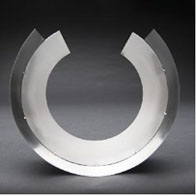Do we live in a hologram? The number of large spacial dimensions is a question that has periodically resurfaced over the years. Theories derived from black hole thermodynamics state that the area of an event horizon is sufficiently large to hold all of the quantum information of the particles that conspired to make the black hole in the first place-provided that the information is encoded in Planck-area bits. Thus, there is no need for a third large, independent spacial dimension. Should there be only two spacial dimensions, then the effects of this “information bound” might be manifest in the noise properties of interferometers. Specifically, two superposed interferometers should see correlated noise at the level of the diffraction spot size of Planck wavelength radiation in the interferometer (the geometric mean of the Planck length and the interferometer arm length). The Fermilab Holometer is an instrument that is being built to test this hypothesis. Shown above is a baffle for the Holometer designed by FCPA postdoc Jason Steffen. A series of these baffles are inserted at specific locations along the arms of two vacuum-enclosed Michelson interferometers in order to prevent contamination of the interfering beams by light scattered from the enclosing walls. These baffles are a small, but important part of the instrument that may finally find the chink in the armor of Einstein’s theory of gravity.
– Jason Steffen










